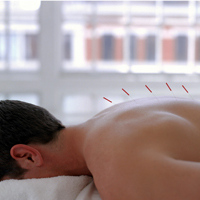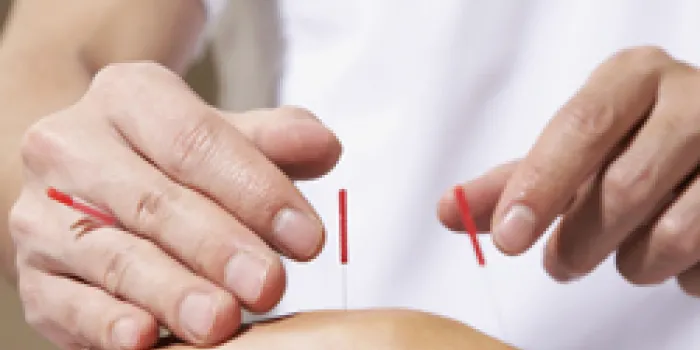Needle pokes are a way of life for many patients with hemophilia, so the thought of paying a professional to insert acupuncture needles may raise a few eyebrows. It may help to think of it not as a series of needle jabs, but as a therapy that can alleviate pain and restore function.
“My experience with acupuncture went rather well,” says Randy Tangco, 42, of Edmond, Oklahoma. He went to an acupuncturist for three months when he was in the Philippines on business a few years ago, to treat pain in his left knee, a result of mild hemophilia A. “I liked it so much. I think it helped alleviate the pain in a longer-term manner,” says the project manager for an insurance company.
If you’re in pain and are considering an alternative, acupuncture may be for you.
Ancient Practice
Acupuncture is an ancient therapy, first practiced in China more than 2,000 years ago. From there it spread to Korea, Japan and other eastern Asian countries. In the past few years, it has gained wider acceptance in the United States.
The therapy is based on the premise that two opposing forces in the body control health: yin and yang. Yin is described as cold, slow and passive; yang as hot, excited and active. When one of them is out of balance, there is a blockage in the flow of energy, or qi (pronounced “chee”), and disease or pain results.
Acupuncture works by restoring the flow of qi through the stimulation of pressure points located on channels called meridians. There are approximately 14 main meridians in the body and about 400 acupuncture points. The meridians have names, and the points have numbers. Each acupuncture point has a different function. Stimulating the points increases or decreases function or sensation in different areas of the body.
The needles used for acupuncture are made of stainless steel and are solid. They are very thin and come in different lengths and widths, ranging from 28- to 40-gauge. The higher the number, the thinner the needle. “I typically use 34- or 38-gauge needles most often in my practice,” says Beth Kohn-Converse, LAc (CA), MTOM, Dipl Ac, Dipl CH, Henry Ford Center for Integrative Medicine, Detroit. She estimates that the needles are 10 to 12 times thinner than a hypodermic needle. “The needles are gently tapped beneath the surface of the skin. They’re not introduced into veins or arteries.” The needles are sterile and never reused, she says. When done properly, acupuncture should not cause bleeding and can be safe to use in people with bleeding disorders.
It is not fully understood how acupuncture works, but research shows that it relieves pain by promoting changes in the body’s biochemistry, particularly neurotransmitters in the brain. “Acupuncture stimulates the release of enkephalins, the body’s natural pain-relieving chemicals, and endorphins, the relaxation chemicals,” Kohn-Converse says.
The needles may penetrate the body’s fascia, tough connective tissue that contains nerve endings and capillaries. Research shows that acupuncture alters blood flow to different areas of the brain. In addition, acupuncture may produce a placebo effect. A patient’s attitude can affect outcome—those with higher expectations report greater pain relief.
Typical Acupuncture Treatment
A typical treatment consists of the placement of five to 20 needles in various parts of the body for 15 to 30 minutes. Before each insertion, the practitioner should swab the skin with an antiseptic, such as alcohol, and use a sterilized needle.
Patients are encouraged to practice relaxation techniques, such as meditation, deep breathing or visualization, while undergoing the procedure. Low-level electrical stimulation can be used on the needles, as can a treatment that employs burning an herb called moxa. “You can use moxibustion therapy in many different ways, such as putting it on top of a needle,” says Kohn-Converse. The burning herb transmits the therapeutic heating sensation through the needle into the acupuncture point. Moxa also comes in the form of a cigar, which, when lit, can be held near the skin above the acupuncture points in a problem area. “According to Chinese medicine theory, it is warming, tonifying and supports blood production,” Kohn-Converse says.
Rx for Ailments
Acupuncture can be used to treat a variety of ailments, from carpal tunnel syndrome to fibromyalgia and headaches. Studies have shown it can help relieve back pain when combined with other therapies. In a 2004 study published in the Annals of Internal Medicine, 190 patients with arthritis and pain in their knees experienced relief and improved function after 26 weeks of acupuncture treatments.
Acupuncture also aids patients post-op. “I have found good results in using it for post-surgical recovery to shorten the healing time, decrease pain syndromes and help decrease scar tissue formation,” says Kohn-Converse.
Although millions of patients have tried acupuncture in the US, the Food and Drug Administration has received few reports of complications. However, infections can occur if needles are improperly sterilized. Some patients have reported soreness and pain after treatment. Rarely, organ puncture has occurred.
Seeing Is Believing
For Angela Lambing, MSN, NP-C, Hemophilia and Thrombosis Treatment Center (HTC), Henry Ford Health System in Detroit, her interest in acupuncture came from a patient with persistent pain. “He had hemophilia with back pain and significant end-stage arthritis in his knees and ankles,” she says. To walk, he hunched over a wheelchair and pushed it. The man routinely rated his pain a 7 on a scale of 1 to 10 (with 10 being the most severe), no matter what the HTC staff tried. “After the first acupuncture treatment, he came to us standing fully upright,” Lambing says. “He didn’t know he was six feet tall.” More importantly, after acupuncture, the man reported his pain a 2 out of 10.
Those results convinced Lambing to formalize her study. The HTC in Detroit and its Twinning Program partner through the World Federation of Hemophilia (WFH), the Karnataka Hemophilia Society in India, conducted the study together. The centers covered the cost of the treatments and transportation during the 10-week study. Of the nine men who completed the study, six were from Michigan, three from India. All were adults with hemophilia, age 28 to 63, with severe joint disease and chronic pain.
[Steps for Living: The Pain Facts]
Factor product, not available in India, was used prior to the treatments for the US patients. The patients received acupuncture treatments for 30 minutes twice a week for four weeks, then weekly for six weeks. The two acupuncturists, Kohn-Converse in the US and Dr. Vinay Varma in India, coordinated their treatments.
“For this study we used points that help move blood, invigorate blood and decrease pain levels,” Kohn-Converse says. Those included some points surrounding the ankle and knee joints. For individuals, treatment protocols can be modified, Kohn-Converse says, but for the study they were kept consistent.
The aftermath of acupuncture therapy was analyzed by comparing the patients’ responses on pre- and post-treatment questionnaires of such measures as pain levels, medication use and quality of life. The results of the study, “Acupuncture for Hemophilia Patients in Chronic Pain,” were given during a poster presentation at the WFH World Congress in Buenos Aires, Argentina, in July 2010. A majority of the patients reported a decrease in pain afterward. “If you look at the pre-and post-scores, I have patients going from a level of 4 down to 2 and 10 to 5, so there was a 50% decrease in several patients,” Lambing says. In addition, most required less pain medication. Further, their movements were more fluid. “Their ability to flex the knee was a little bit more improved,” Lambing says. “Their walking stature was a little bit quicker afterward.”
Tangco also experienced some noticeable results. “Before the session, I would usually limp,” he says. “But after every session it allowed me to walk straight for at least a couple of days. It made me feel like I didn’t have a bad knee.” Patients tend to feel invigorated or relaxed after treatments. “I’ve found that emotionally, people in the study were much calmer,” says Kohn-Converse. “Their central nervous systems were more regulated and balanced, so they felt better overall—that’s important in managing any chronic ailment.”
Lambing acknowledges that her study sample was small, so statistical significance cannot be suggested. However, she feels it accomplished two objectives. “One was that there wasn’t any bleeding from the procedure,” she says. “The other is that acupuncture demonstrated some improvement in the patients’ reported pain. It can be used as an adjunct, or as an additional approach, to multimodal pain care.”
Doing Your Homework
If you are tempted to try acupuncture, keep in mind a few things before scouring the Internet to find a practitioner. First, talk to your hematologist or the staff at your HTC. “Make sure the person you do choose is certified and knows what they’re doing,” says Lambing. Certification for acupuncturists in the US comes from the National Certification Commission for Acupuncture and Oriental Medicine. On its Web site, you can find practitioners who have passed the national qualifying exam and/or state exams, says Kohn-Converse.
Some states have individual licensing or registration requirements. But be forewarned—some states have yet to establish guidelines. “Michigan does not have a state exam, nor do they have licensure, but I trained in California, so I was board-certified there,” Kohn-Converse says. “My national certification has allowed me to practice in other states.” Practitioners undergo recertification every few years. Like other providers, acupuncturists earn continuing-education units throughout their careers.
Check with your insurance company to see if it covers acupuncture, considered a complementary and alternative medicine. A 2004 Kaiser Family Foundation Survey found that 50% of Americans who had employee health insurance plans were covered.
Sometimes, it may be an issue of mind over matter. “Acupuncture is under the holistic umbrella, so we really are talking about that mind-body connection,” says Kohn-Converse. Adds Lambing, “The brain is the most powerful organ in the body.”

